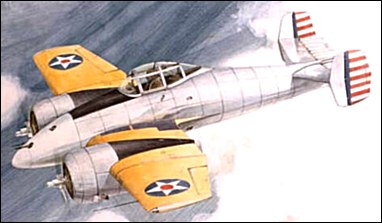|
| The Grumman G-34 proposal of 1938 for a single-seat twin-engined shipboard fighter anticipated the realisation of an operational production example of such a type by quite a few years. In fact, the proposal was then considered to be so advanced that it bordered on the revolutionary; yet only four years later, on 18 April 1942,16 North American B-25 twin-engined bombers were flown off the USS Hornet to attack Tokyo.
Not only was the G-34 an advanced concept, in its original form it was a most unusual-looking aircraft, with the leading edge of its low-set monoplane wing forward of the fuselage nose. The tail unit had twin endplate fins and rudders, and the landing gear was of the retractable tailwheel type, with the main units retracting aft into the wing-mounted engine nacelles. Powerplant comprised two Wright R-1820 Cyclones, each with a three-bladed propeller, these being geared to counter-rotate to offset the effects of propeller torque.
The US Navy was first to order a prototype, the XF5F-1, on 30 June 1938, which was flown for the first time on 1 April 1940. A number of modifications were introduced subsequently, the most noticeable being an extension of the fuselage nose so that it terminated forward of the wing. Although failing to win a production order, the XF5F-1 soldiered on until withdrawn from use in December 1944, having done some useful work as a development prototype for the more advanced Grumman F7F. A land-based version of Grumman's design interested the US Army Air Force, which ordered a single XP-50 prototype. Although generally similar to the naval version, it differed by having a lengthened nose to accommodate the nosewheel of the tricycle landing gear and had as powerplant two Wright R-1820-67/-69 turbocharged engines. First flown on 14 May 1941, the XP-50 was plagued with engine overheating problems and was eventually written off after suffering serious damage when a turbocharger exploded. No further examples of the XP-50 were built.
 | A three-view drawing (1280 x 782) |
| MODEL | XP-50 |
| CREW | 1 |
| ENGINE | 1 x Wright R-1820-67/-69 |
| Anonymous, 16.03.2022 21:34 This was the Grumman F5F redesigned as a fighter for the US Army Air Corps. The reason for the lengthened nose was that the Army version included a tricycle landing gear instead of a tail wheel. Presumably, the Army preferred the Lockheed P-38. reply | | Carl Felty, e-mail, 12.07.2011 02:57 The short nosed version of this airplane was the one flown by the Blackhawks in the comic book series. Later they started using jets and were flying, what appeared to be the F-90. reply | | dafacai, 20.06.2011 07:16 toward the middle of Long Island Sound, and the Coast Guard plucked him from the water minutes later, avoiding certain death by hypothermia. reply |
| Ted Jones, e-mail, 20.04.2011 16:58 In the late 1970s I visited with Bob Hall, retired Grumman aircraft engineer and test pilot. I noticed a photograph Bob had of a twin engined plane with pre-WWII Army Air Corps markings, and asked Bob what it was.
He told me about the XP-50 which he flew on the first and only flight. This was Grumman's first tricicle gear A /C and when Bob cycled the gear, the nose wheel failed to drop. Subsequently, according to Bob, the main gear failed to retract. He spent several hours in the air trying everything he or the ground could think of, but the nose gear remained retracted and the main gear remained down. Bob said he bailed out and put the A /C into Long Island Sound.
Subsequently, I have read a draft of a biograpphy of Bob started, but not yet published, by his son Eric which goes into greater detail, including the decision for Bob to bail our over Long Island Sound's frigid April waters. The bail out was coordiated with the U.S. Coast Guard station at Eatons Neck. Bob jumped close over Eaton's Neck, after heading the A /C toward the middle of Long Island Sound, and the Coast Guard plucked him from the water minutes later, avoiding certain death by hypothermia.
Bob's comment to me was: "It wasn't a good aircraft anyway." No more were ever built, he said.
IMHO Bob Hall was an aviation pioneer whose career with the Granville Brothers and Grumman has been almost totally ignored by aircraft historians. I hope Eric gets to finish his biography and that it gets published. reply |
|
| | XWXwireXWX, e-mail, 17.04.2011 05:51 Anyone notice the incredible striking resemblance between this craft, the XF5F, and the F7F? This craft, which retains the short, twin-tailed fuselage of the XF5F, but uses the twin engine (Non-twin-boom, like the P-38, where the engines have their own fuselage{Sorta}) powerplant and moves the wings back into the position of many twin-engine fighters. The Armament is also the same as the Tigercat's. reply | | TIM, e-mail, 18.03.2011 16:51 DOES ANYONE HAVE PLANS / INFORMATION TO BULID AN R /C MODEL OF THE XP-50 OR XF5F-1?? IF YES, WHAT IS THE COST FOR THE PLANS?? reply |
|
Do you have any comments?
|
| 
COMPANY
PROFILE
All the World's Rotorcraft
|



 Ted Jones
Ted Jones Ted Jones
Ted Jones





Looking for crash report on the Grumman XP-50 skyrocket plane. I am a underwater archeologist that when down in May 14 1940 or information??
reply